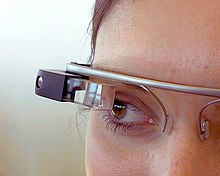Google Glass is a type of wearable technology with an optical head-mounted display (OHMD). It was developed by Google X with the mission of producing a mass-market ubiquitous computer. Google Glass displays information in a smartphone-like hands-free format. Wearers communicate with the Internet via natural language voice commands. Google started selling a prototype of Google Glass to qualified "Glass Explorers" in the US on April 15, 2013, for a limited period for $1,500, before it became available to the public on May 15, 2014, for the same price.
On January 15, 2015, Google announced that it would stop producing the Google Glass prototype but remained committed to the development of the product. According to Google, Project Glass was ready to "graduate" from Google Labs, the experimental phase of the project.
DEVELOPMENT.
Google Glass was developed by Google X, the facility within Google devoted to technological advancements such as driverless cars.
Google Glass is smaller and slimmer than previous head-mounted display designs.
The Google Glass prototype resembled standardeyeglasses with the lens replaced by a head-up display. In mid-2011, Google engineered a prototype that weighed 8 pounds (3,600 g); by 2013 they were lighter than the average pair of sunglasses.
In April 2013, the Explorer Edition was made available to Google I/Odevelopers in the United States for $1,500.

A Glass prototype seen at
Google
The product was publicly announced in April 2012. Sergey Brin wore a prototype of the Glass to an April 5, 2012, Foundation Fighting Blindness event in San Francisco. In May 2012, Google demonstrated for the first time how Google Glass could be used to shoot video.
Google provided four prescription frame choices for $225 and free with the purchase of any new Glass unit. Google entered in a partnership with the Italian eyewear company Luxottica, owners of the Ray-Ban, Oakley, and other brands, to offer additional frame designs. In June 2014, Nepal Government adoptedGoogle Glass for tackling poachers of wild animals and herbs of Chitwan International Park and other parks listed under World heritage sites. Gurkha Military currently uses Google Glass to track the animals and birds in the jungle. This operation led to the latest development in military operation. Google Glass was used in military for the first time in the world by Nepal.
In January 2015, Google ended the beta period of Glass (the "Google Glass Explorer" program)














